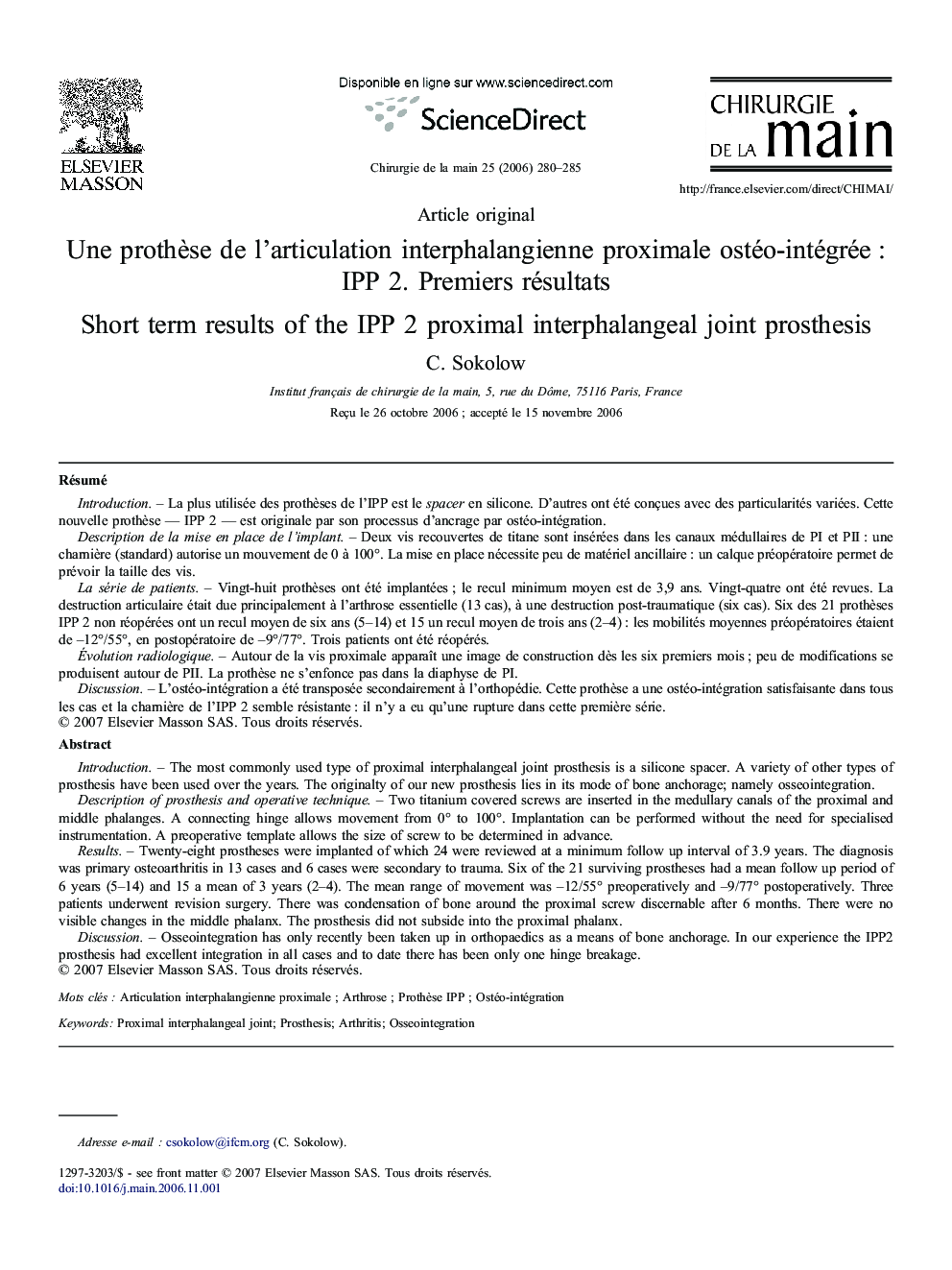| Article ID | Journal | Published Year | Pages | File Type |
|---|---|---|---|---|
| 4049837 | Chirurgie de la Main | 2006 | 6 Pages |
RésuméIntroductionLa plus utilisée des prothèses de l'IPP est le spacer en silicone. D'autres ont été conçues avec des particularités variées. Cette nouvelle prothèse — IPP 2 — est originale par son processus d'ancrage par ostéo-intégration.Description de la mise en place de l'implantDeux vis recouvertes de titane sont insérées dans les canaux médullaires de PI et PII : une charnière (standard) autorise un mouvement de 0 à 100°. La mise en place nécessite peu de matériel ancillaire : un calque préopératoire permet de prévoir la taille des vis.La série de patientsVingt-huit prothèses ont été implantées ; le recul minimum moyen est de 3,9 ans. Vingt-quatre ont été revues. La destruction articulaire était due principalement à l'arthrose essentielle (13 cas), à une destruction post-traumatique (six cas). Six des 21 prothèses IPP 2 non réopérées ont un recul moyen de six ans (5–14) et 15 un recul moyen de trois ans (2–4) : les mobilités moyennes préopératoires étaient de –12°/55°, en postopératoire de –9°/77°. Trois patients ont été réopérés.Évolution radiologiqueAutour de la vis proximale apparaît une image de construction dès les six premiers mois ; peu de modifications se produisent autour de PII. La prothèse ne s'enfonce pas dans la diaphyse de PI.DiscussionL'ostéo-intégration a été transposée secondairement à l'orthopédie. Cette prothèse a une ostéo-intégration satisfaisante dans tous les cas et la charnière de l'IPP 2 semble résistante : il n'y a eu qu'une rupture dans cette première série.
IntroductionThe most commonly used type of proximal interphalangeal joint prosthesis is a silicone spacer. A variety of other types of prosthesis have been used over the years. The originalty of our new prosthesis lies in its mode of bone anchorage; namely osseointegration.Description of prosthesis and operative techniqueTwo titanium covered screws are inserted in the medullary canals of the proximal and middle phalanges. A connecting hinge allows movement from 0° to 100°. Implantation can be performed without the need for specialised instrumentation. A preoperative template allows the size of screw to be determined in advance.ResultsTwenty-eight prostheses were implanted of which 24 were reviewed at a minimum follow up interval of 3.9 years. The diagnosis was primary osteoarthritis in 13 cases and 6 cases were secondary to trauma. Six of the 21 surviving prostheses had a mean follow up period of 6 years (5–14) and 15 a mean of 3 years (2–4). The mean range of movement was –12/55° preoperatively and –9/77° postoperatively. Three patients underwent revision surgery. There was condensation of bone around the proximal screw discernable after 6 months. There were no visible changes in the middle phalanx. The prosthesis did not subside into the proximal phalanx.DiscussionOsseointegration has only recently been taken up in orthopaedics as a means of bone anchorage. In our experience the IPP2 prosthesis had excellent integration in all cases and to date there has been only one hinge breakage.
